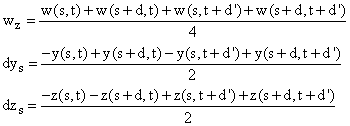| |
|||||
When a surface S is described in parametric form, that is, you are given functions x(s, t), y(s, t) and z(s, t), and a region of values for s and t, you can use a spreadsheet to obtain the flux integral of any spreadsheet definable vector function w (that is the dot product of w with the normal to the surface) over it. You can do so by exploiting the ability of the spreadsheet to copy a single instruction to a large array of locations in two dimensions, row and column. Let us suppose you want to integrate over s first and then t, and you will
integrate from t1 to t2, and from s1(t) to s2(t).
Suppose you want to break each range into N, N = 100 pieces. Set up an array of t values, assigning t1 to the first row that
you use in the first column, and (previous + (t2 - t1) /
N) in the next row beneath it, and (2 * previous - (previous to previous)) beneath
that. Copy that into the next 98 rows. Then set the next column entry to "=
entry to left" ; copy that into the next 98 columns and rows. Next set up two columns that compute s1(t) and s2(t)
for each t value. wx * (dysdzt - dytdzs) + wy * (dzsdxt - dztdxs) + wx * (dxsdyt - dxtdys). To compute this for every 2 x 2 rectangle in the arrays again you need only compute it for the top left one and copy again to a 100 by 100 array. This can be done in one step or once for each term. The integral will be the sum of this over the entire array. What do you do to get wx or dys or dzt for
a pair of intervals? Then the analogue of the trapezoid rule in two dimensions gives
Though it is messy to create this last array, it really only has to be done in one square and copied, and also only has to be done once, and can be reused with different integrals, if the other arrays have the same start points. Notice that to change the domain for s and t you need only change the first two arrays; to change the parametrization you need only change the x, y and z arrays, and to change the vector w whose flux integral you are computing you need only change its three arrays. You can get integrals over subsets of the surface by taking different sums over the last array. An example with t1 =1, t2 = 2, s1 = t2, s2 = t3,
The results for this integral are 132.2450414 for N = 100, 132.1941481 for N = 50, and 131.9909671 for N = 25. The difference between these is roughly 4 times smaller between 50 and 100 than it is between 25 and 50. Multiplying the better by 4/3 and subtracting the worse multiplied by 1/3 gives 132.262006 and 132.261875. Extrapolating assuming that the remaining error goes down by a factor of 16 gives an estimate of 132.2620145, which is probably accurate to 6 decimal places. This can be verified by enlarging the arrays and trying N = 200, something which requires only copying, and forming one new sum. Exercise 25.6 Change s and t to go from 0 to |
||||||||||||||||||||||||||


